|
|
|
|
 |
Hoca Ali Riza
|
|
(1858 - 1939) was a Turkish painter.
Portrait of Hoca Ali Riza
Kizkulesi (Leander Tower), painting by Hoca Ali RizaBorn in Uskudar, Istanbul. Painted many landscapes of Istanbul and especially Uskudar. Attended Kuleli Military High School and then the Military Academy. There he studied under Osman Nuri Pasha, Seleyman Seyyid and Monsieur Gues, and graduated in 1884. From 1909 to 1912 he served as President of the Society of Ottoman Painters.
|
|
|
|
|
|
 |
HOGARTH, William
|
|
British Painter and Printmaker, 1697-1764
English painter and engraver. He played a crucial part in establishing an English school of painting, both through the quality of his painting and through campaigns to improve the status of the artist in England. He also demonstrated that artists could become independent of wealthy patrons by publishing engravings after their own paintings. |
|
|
|
 |
HOLBEIN, Ambrosius
|
|
German Northern Renaissance Painter, 1494-ca.1519
Painter, draughtsman and designer of woodcuts, son of Hans Holbein. In the drawing of Ambrosius and Hans Holbein the Younger (1511; Berlin, Kupferstichkab.) by their father, Hans's age is given as 14, and although that of Ambrosius cannot be read clearly, he appears to have been the elder brother. In 1514 he was probably working near the Bodensee, and a Virgin and Child (Basle, Kstmus.), with the coat of arms of Johann von Botzheim, Canon of Konstanz Cathedral (c. 1480-1535), appears to be his work. In 1515 he was working as a journeyman to the painter Thomas Schmid (c. 1480-c. 1550-60) on the decoration of the abbot's Festsaal in the Benedictine St Georgkloster at Stein-am-Rhein, which included allegorical figures of women, one of which, Death with a Female Lute-player (in situ), is signed AH. Also in 1515 he joined his brother Hans in Basle, where together they decorated with marginal drawings (1515-16) the copy of Erasmus's Praise of Folly (Basle, Kstmus.) belonging to the schoolmaster Myconius (Oswald Geissh?sler; d 1552); the distinction between the hands of the two brothers can be made only on stylistic grounds. They also painted a school sign for Myconius, each apparently working on a different side. On 25 July 1516 Ambrosius was recorded staying in the house of the painter Hans Herbst, in whose workshop he may have been employed. On 14 February 1517 he was enrolled in the Basle painters' guild, and on 5 June 1518 he became a citizen of the city. Numerous woodcut designs executed for Basle printers from 1517 onwards and signed with Ambrosius Holbein's initials survive, most of which are set in architectural frameworks inspired by the Italian Renaissance, |
|
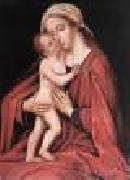 |
HOLBEIN, Hans the Elder
|
|
(b. 1460/65, Augsburg, d. 1524, Isenheim
was a German painter. He was born in Augsburg, Bavaria and died in Isenheim, Alsace. He and his brother Sigismund Holbein painted religious works in the late Gothic style. Hans the Elder was a pioneer and leader in the transformation of German art from the Gothic to the Renaissance style. He was also a woodcut artist and an illustrator of books, and was a church window designer. |
|
 |
HOLBEIN, Hans the Younger
|
|
German painter (b. 1497, Augsburg, d. 1543, London).
Hans Holbein the Younger, born in Augsburg, was the son of a painter, Hans Holbein the Elder, and received his first artistic training from his father. Hans the Younger may have had early contacts with the Augsburg painter Hans Burgkmair the Elder. In 1515 Hans the Younger and his older brother, Ambrosius, went to Basel, where they were apprenticed to the Swiss painter Hans Herbster. Hans the Younger worked in Lucerne in 1517 and visited northern Italy in 1518-1519. On Sept. 25, 1519, Holbein was enrolled in the painters' guild of Basel, and the following year he set up his own workshop, became a citizen of Basel, and married the widow Elsbeth Schmid, who bore him four children. He painted altarpieces, portraits, and murals and made designs for woodcuts, stained glass, and jewelry. Among his patrons was Erasmus of Rotterdam, who had settled in Basel in 1521. In 1524 Holbein visited France. Holbein gave up his workshop in Basel in 1526 and went to England, armed with a letter of introduction from Erasmus to Sir Thomas More, who received him warmly. Holbein quickly achieved fame and financial success. In 1528 he returned to Basel, where he bought property and received commissions from the city council, Basel publishers, Erasmus, and others. However, with iconoclastic riots instigated by fanatic Protestants, Basel hardly offered the professional security that Holbein desired. In 1532 Holbein returned to England and settled permanently in London, although he left his family in Basel, retained his Basel citizenship, and visited Basel in 1538. He was patronized especially by country gentlemen from Norfolk, German merchants from the Steel Yard in London, and King Henry VIII and his court. Holbein died in London between Oct. 7 and Nov. 29, 1543. With few exceptions, Holbein's work falls naturally into the four periods corresponding to his alternate residences in Basel and London. His earliest extant work is a tabletop with trompe l'oeil motifs (1515) painted for the Swiss standard-bearer Hans Baer. Other notable works of the first Basel period are a diptych of Burgomaster Jakob Meyer zum Hasen and his wife, Dorothea Kannengiesser (1516); a portrait of Bonifacius Amerbach (1519); an unsparingly realistic Dead Christ (1521); a Madonna and Child Enthroned with Two Saints (1522); several portraits of Erasmus, of which the one in Paris (1523 or shortly after), with its accurate observation of the scholar's concentrated attitude and frail person and its beautifully balanced composition, is particularly outstanding; and woodcuts, among which the series of the Dance of Death (ca. 1521-1525, though not published until 1538) represents one of the high points of the artist's graphic oeuvre. Probably about 1520 Holbein painted an altarpiece, the Last Supper, now somewhat cut down, which is based on Leonardo da Vinci's famous painting, and four panels with eight scenes of the Passion of Christ (possibly the shutters of the Last Supper altarpiece), which contain further reminiscences of Italian painting, particularly Andrea Mantegna, the Lombard school, and Raphael, but with lighting effects that are characteristically northern. His two portraits of Magdalena Offenburg, as Laïs of Corinth and Venus with Cupid (1526), |
|
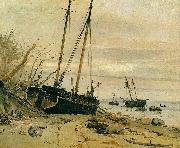 |
holger drachmann
|
|
född 9 oktober 1846 i Köpenhamn, död 14 januari 1908 i Hornbæk, var en dansk författare.
Drachmann försökte sig först på måleri, men gav upp och ägnade sig i stället åt författande. Han skrev noveller, dikter, romaner och skådespel.
Edvard Grieg satte musik till många av Drachmanns dikter, bland annat Reiseminder fra Fjeld og Fjord, opus 44. En av hans mest berömda dikter är Et andnat Skagen. |
|
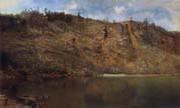 |
Homer Dodge Martin
|
|
American Barbizon School Tonalist Painter, 1836-1897, He was an American artist, particularly known for his landscapes. Martin was born at Albany, New York. A pupil for a short time of William Hart, his earlier work was closely aligned with the Hudson River School. He was elected as associate of the National Academy of Design, New York, in 1868, and a full academician in 1874. During a trip to Europe in 1876 he was captivated by the Barbizon school, and thereafter his painting style gradually became darker, moodier, and more loosely-brushed. From 1882 to 1886 he lived in France, spending much of the time in Normandy. |
|
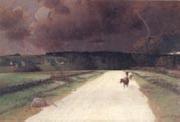 |
Homer Watson
|
|
Canadian Painter, 1855-1936
Canadian painter. The son of a mill-owner, he was born in a region of rural southern Ontario, which he painted throughout his life. In 1874 he moved to Toronto to work at the Notman Photographic Studios; he also spent many hours copying paintings in the Toronto Normal School in order to improve his technique. In 1876 he visited New York, where he was impressed with the carefully composed paintings of the Hudson River school and the rural scenes of George Inness, who encouraged Watson to pursue his career. The following year he returned to Doon to work up his New York sketches into finished paintings. A work of this early period, Landscape with River (1878; Toronto, A.G. Ont.), |
|
|
|
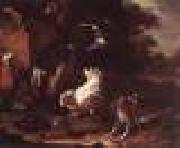 |
HONDECOETER, Melchior d
|
|
Dutch Baroque Era Painter, 1636-1695
Dutch animal painter. His grandfather, Gillis d'Hondecoeter (d. 1638) and his father, Gysbert d'Hondecoeter (1604?C1653), were landscape and animal painters. After four years at The Hague, where he painted The Menagerie of William III at Loo, Melchior settled in Amsterdam. He painted all forms of animal life, but is best known for his depiction of birds and fowl, in which he has few equals. Representative works, executed in a smooth, precise style, include the Dead Cock |
|
|
|
 |
Honore Daumier
|
|
1808-1879
French
Honore Daumier Locations
In some 40 years of political and social commentary Honore Daumier created an enormously rich and varied record of Parisian middle-class life in the form of nearly 4,000 lithographs, about 1,000 wood engravings, and several hundred drawings and paintings. In them the comic spirit of Moli??re comes to life once again. After having been the scourge of Louis Philippe and the July Monarchy (1830-1848), Daumier continued as a satirist of Louis Napoleon and the Second Empire (1851-1870). Poor himself, the artist sympathized with the struggling bourgeois and proletarian citizens of Paris. As a man of the left, he battled for the establishment of a republic, which finally came in 1870. Liberals have always applauded Daumier; some conservatives, however, have been inclined to consider him woolly-minded.
Honore Daumier, born on Feb. 26, 1808, in Marseilles, was the son of a glazier. When Honore was 6, the family moved to Paris, where the elder Daumier hoped to win success as a poet. Honore grew up in a home in which humanistic concerns had some importance. A born draftsman and designer who was largely self-taught, he received some formal instruction from Alexandre Lenoir, one of Jacques Louis David students. An obscure artist named Ramelet taught Daumier the elements of the new, inexpensive, and popular technique of lithography. Daumier style is so much his own that it is not easy to disentangle influences from other artists. Rembrandt and Francisco Goya are usually mentioned, along with Peter Paul Rubens, the Venetian school, and photography. |
|
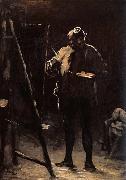 |
Honore Daumier
|
|
French Realist Illustrator, 1808-1879
was a French printmaker, caricaturist, painter, and sculptor, whose many works offer commentary on social and political life in France in the 19th century. A prolific draftsman who produced over 4000 lithographs, he was perhaps best known for his caricatures of political figures and satires on the behavior of his countrymen, although posthumously the value of his painting has also been recognized. Daumier was born in Marseille to Jean-Baptiste Louis Daumier and C??cile Catherine Philippe. His father Jean-Baptiste was a glazier whose literary aspirations led him to move to Paris in 1814, seeking to be published as a poet. In 1816 the young Daumier and his mother followed Jean-Baptiste to Paris. Daumier showed in his youth an irresistible inclination towards the artistic profession, which his father vainly tried to check by placing him first with a huissier, for whom he was employed as an errand boy, and later, with a bookseller. In 1822 he became prot??g?? to Alexandre Lenoir, a friend of Daumier's father who was an artist and archaeologist. The following year Daumier entered the Acad??mie Suisse. He also worked for a lithographer and publisher named Belliard, and made his first attempts at lithography. Having mastered the techniques of lithography, Daumier began his artistic career by producing plates for music publishers, and illustrations for advertisements. |
|
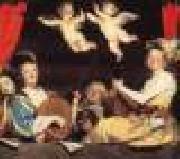 |
HONTHORST, Gerrit van
|
|
Dutch Baroque Era Painter, ca.1590-1656
Dutch portrait, genre, and allegorical painter. In Italy (c.1610?C1620) he gained a sound understanding of the works of Caravaggio, which greatly affected his style. He was a master at painting candlelit genre pieces and biblical scenes. Upon his return to Holland, he introduced the Italian manner of illusionistic decoration into Dutch interiors, as in his decorative scheme for the palace of Honselaarsdijk. In 1628, Charles I invited him to England, where he decorated Whitehall and painted portraits of the king and nobility. Several of these are now in the National Gallery, London. He also worked for the court of Denmark, and from 1637 to 1652 at The Hague. Together with Terbrugghen and Baburen he led the influential Utrecht school of painting that introduced Caravaggesque dramatic realism into Dutch art. |
|
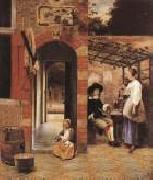 |
HOOCH, Pieter de
|
|
Dutch Baroque Era Painter, 1629-1684
Dutch painter. He was one of the most accomplished 17th-century Dutch genre painters, excelling in the depiction of highly ordered interiors with domestic themes and merry companies and pioneering the depiction of genre scenes set in a sunlit courtyard. The hallmarks of his art are an unequalled responsiveness to subtle effects of daylight, and views to adjoining spaces, either through a doorway or a window, |
|
|
|
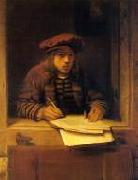 |
HOOGSTRATEN, Samuel van
|
|
Dutch Baroque Era Painter, 1627-1678
Dutch painter, draughtsman, engraver and writer. His multi-faceted art and career testify amply to the unflagging ambition attributed to him as early as 1718 by his pupil and first biographer, Arnold Houbraken. During his lifetime van Hoogstraten was recognized as a painter, poet, man of letters, sometime courtier and prominent citizen of his native city of Dordrecht, where he served for several years as an official of the Mint of Holland. Today he is remembered not only as a pupil and early critic of Rembrandt, but also as a versatile artist in his own right. His diverse oeuvre consists of paintings, drawings and prints whose subjects range from conventional portraits, histories and genre pictures to illusionistic experiments with trompe-l'oeil still-lifes, architectural perspectives and perspective boxes. |
|
|
|
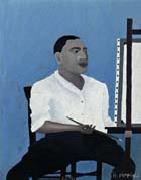 |
Horace pippin
|
|
1888-1946
was a self-taught African-American painter who worked in a naive style. The injustice of slavery and American segregation figure prominently in many of his works. He was born in West Chester, Pennsylvania, and grew up in Goshen, New York. There he attended segregated schools until he was 15, when he went to work to support his ailing mother.Pippin served in the 369th infantry in Europe during World War I, where he lost the use of his right arm. He said of his combat experience: His activity as a painter did not begin in earnest until 1930. One of his best-known paintings, his Self-portrait of 1941, shows him seated in front of an easel, cradling his brush in his right hand (he used his left arm to guide his injured right arm when painting). His painting of John Brown Going to his Hanging (1942) is in the collection of the Pennsylvania Academy of the Fine Arts in Philadelphia. Among Pippin's works are many genre paintings, such as the Domino Players (1943), in the Phillips Collection, Washington D.C., and several versions of Cabin in the Cotton. |
|
 |
Horace Vernet
|
|
French Academic Painter, 1789-1863, Painter, son of Carle Vernet. He was born in his father's lodgings at the Palais du Louvre, where his grandfather Joseph Vernet also lived; his maternal grandfather was Jean-Michel Moreau. To these antecedents and influences are ascribed the supreme ease of his public career, his almost incredible facility and his fecundity. His early training in his father's studio was supplemented by formal academic training with Franeois-Andre Vincent until 1810, when he competed unsuccessfully for the Prix de Rome. He first exhibited at the Salon in 1812. In 1814 Vernet received the Legion d'honneur for the part he played in the defence of Paris, which he commemorated in the Clichy Gate: The Defence of Paris, 30 March 1814 |
|
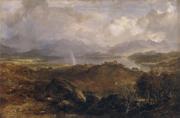 |
Horatio Mcculloch
|
|
Scottish Landscape painter ,1805-1867
Scottish painter. He was trained in the studio of the Glasgow landscape painter John Knox (1778-1845) and at first earned his living as a decorative painter. By the early 1830s McCulloch's exhibits with the Glasgow Dilettanti Society and with the Royal Scottish Academy had begun to attract buyers, notably the newly instituted Association for the Promotion of the Fine Arts in Scotland. Commissions from book and print publishers allowed him to concentrate on easel painting. On his election as full Academician of the Scottish Academy in 1838, McCulloch settled in Edinburgh and soon became a prominent figure in the artistic life of the capital and a prolific contributor to the Royal Scottish Academy exhibitions. At the same time contact with Glasgow was maintained: McCulloch's favourite sketching grounds were in the west, he exhibited regularly in the city and his most loyal patrons were wealthy Glasgow industrialists such as David Hutcheson (1799-1881), the steamship owner. He seldom exhibited outside Scotland and only once at the Royal Academy, London (1843), but he kept in touch with London artist-friends, John Phillip, David Roberts and John Wilson (1774-1855), through correspondence and visits. His own art collection was evidence of his admiration for 17th-century Dutch painters, for J. M. W. Turner and Richard Wilson. |
|
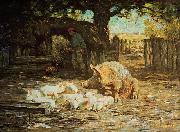 |
Horatio Walker
|
|
(May 12, 1858 - September 27, 1938) was a respected and commercially successful Canadian painter. He worked in oils and watercolors, often depicting scenes of rural life in Canada. He was highly influenced by the French Barbizon school of painting.
Horatio Walker was born in 1858 to parents Thomas and Jeanne Maurice Walker. Thomas Walker emigrated in 1856 from Yorkshire, England, to Listowel, Ontario, with his wife of French and English heritage. Having some wealth, Thomas purchased land for lumber in Midwestern Ontario and Horatio was raised in relative comfort. His interest in art may originate from his father who crafted small figures as a hobby, and both his father and the local school teacher encouraged drawing as a pastime.
In 1870, on Walkeres 12th birthday, his father brought him to Quebec City, Quebec, for the first time. His father made occasional business trips to the city as part of his timber business. During this sojourn, they visited the Île d'Orleans, in search of pine timber. Walker made subsequent visits to Quebec City during the following years. His formal schooling ended at the Listowel Public School in 1872; he never went on to pursue formal academic training in art. At the age of 15, Walker moved to Toronto, Ontario to apprentice with the photographic firm Notman and Fraser. It was a fortunate opportunity, as several successful artists worked also there; Walker learned watercolour from Robert Gagnon, miniature portrait painting from John Fraser, and painting from Lucius OeBrien and Henri Perre. |
|
|
|
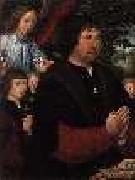 |
HORENBOUT, Gerard
|
|
Flemish Northern Renaissance Painter and Manuscript Illuminator, ca.1465-1541
Painter, designer, scribe and cartographer. He may have been the pupil of Li?vin de Stoevere ( fl 1463), the only painter of the five artists who guaranteed his admission fee into the guild of painters and illuminators in Ghent in 1487. Horenbout became a versatile and productive artist, painting altarpieces, portraits and illuminated manuscripts and designing tapestries and stained-glass windows. He also collaborated with the nuns of the convent of Galilee near Ghent in making a model garden with flowers made of cloth that he delivered to Margaret of Austria, Regent of the Netherlands, at her court in Mechelen. He seems to have achieved a degree of wealth commensurate with his output: in 1503 he acquired a house |
|
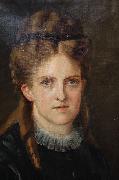 |
Horst Devens
|
|
painted Freiin Emma von Langenmantel-Rosenberg in 1873 |
|
|
|
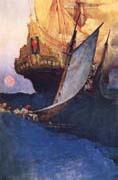 |
Howard Pyle
|
|
One of the great illustrators of the 19th century.
American
1853-1911
was an American illustrator and writer, primarily of books for young audiences. A native of Wilmington, Delaware, he spent the last year of his life in Florence, Italy. In 1894 he began teaching illustration at the Drexel Institute of Art, Science and Industry (now Drexel University), and after 1900 he founded his own school of art and illustration called the Howard Pyle School of Illustration Art. The term the Brandywine School was later applied to the illustration artists and Wyeth family artists of the Brandywine region by Pitz (later called the Brandywine School). Some of his more famous students were Olive Rush, N. C. Wyeth, Frank Schoonover, Elenore Abbott, and Jessie Willcox Smith. His 1883 classic The Merry Adventures of Robin Hood remains in print to this day, and his other books, frequently with medieval European settings, include a four-volume set on King Arthur that cemented his reputation. He wrote an original work, Otto of the Silver Hand, in 1888. He also illustrated historical and adventure stories for periodicals such as Harper's Weekly and St. Nicholas Magazine. |
|
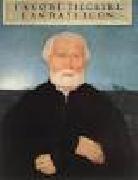 |
HUBER, Wolf
|
|
German Northern Renaissance Painter, ca.1490-1553 |
|
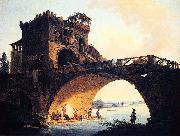 |
Hubert Robert
|
|
(22 May 1733 - 15 April 1808), French artist, was born in Paris.
His father, Nicolas Robert, was in the service of François-Joseph de Choiseul, marquis de Stainville a leading diplomat from Lorraine. Young Robert finished his studies with the Jesuits at the College de Navarre in 1751 and entered the atelier of the sculptor Michel-Ange Slodtz who taught him design and perspective but encouraged him to turn to painting. In 1754 he left for Rome in the train of Étienne-François de Choiseul, son of his father's employer, who had been named French ambassador and would become a Secretary of State for Foreign Affairs to Louis XV in 1758.
|
|
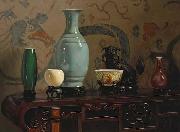 |
Hubert Vos
|
|
(1855-1935) was a Dutch painter who was born in Maastricht on February 15, 1855. He studied at the Academie Royale des Beaux-Arts in Brussels and with Fernand Cormon (1845-1924) in Paris. He exhibited widely in Paris, Amsterdam, Brussels, Dresden and Munich. From 1885 to 1892, he worked in England, where he exhibited at the Royal Academy between 1888 and 1891. He was a member of the Royal Society of British Artists.
In 1898, he visited Hawaii, where he painted the local people. In that same year, Vos traveled to Korea, where he completed at least three paintings in duplicate. In each case, he left one copy in Korea and kept one copy. The paintings are a life-sized portrait of Emperor Gojong, a portrait of Min Sang-ho (1870-1933) and a landscape of Seoul. The copies left in Korea hung in the Deoksugung Palace until all except the landscape of Seoul, were destroyed by fire in 1904. In 1905, on his second and last trip around the world. |
|
|
|
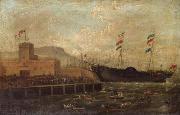 |
Hugh Carroll Frazer
|
|
(February 22, 1891 - July 9, 1975) was born in the Martinsburg, West Virginia. He graduated from the United States Naval Academy in 1912. He received the Medal of Honor for actions at the United States occupation of Veracruz, 1914. Frazer was a World War I veteran. |
|
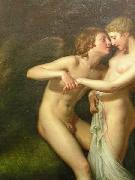 |
Hugh Douglas Hamilton
|
|
(c. 1740 - 10 February 1808) was an Irish portrait-painter.
Biography
Hamilton was born in Crow Street, in Dublin, Ireland, in 1740, the son of a peruke maker. Unfortunately there is very little concrete evidence for his earlylife, apart from his own drawings. He studied art under Robert West at the Dublin Society House - and won some early success with crayon and pastel portraits there. He was very adept at building relationships with patrons from the early days, taking up with the famous La Touche banking family of Dublin, who had close ties with the Bank of Ireland.
Very little is known of Hamilton's career between 1756 and 1764, when he moved to London. Hamilton found great success in London through his pastel oval portraits, portraying royalty, politicians and celebrities of the day through this medium. Hamilton was often overwhelmed with orders, including commissions from the British royal family - such as Queen Charlotte (1764) and others now in the British Royal Collection. He showed with the Society of Artists and the Free Society of Artists from the mid-1760s to the mid-1770s. From the mid-1770s on, Hamilton became very interested in a softer, more textural form of pastel "fresco", in which he blended crayons and chalk to further the pastel's ability to imitate flesh.
In 1779 he travelled to Italy, where he remained for the next twelve years, occasionally visiting Florence but mainly based in Rome, where he knew Antonio Canova. On the advice of artist John Flaxman Hamilton turned to oil painting, and achieved great success with small oval portraits of Irish and British visitors. His portraits of this period include those of Dean Kirwan (displayed at the Royal Dublin Society), George John, 2nd Earl Spencer, Countess Cowper (1787), and the exiled Charles Edward Stuart ( Lord Edward, 1785).
In 1791 Hamilton returned to Dublin, where he died. In 1796 he painted Lord Edward Fitzgerald, the Irish revolutionary.
|
|
|
|
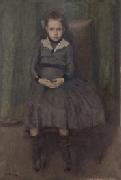 |
Hugh Ramsay
|
|
Australian portrait painter ,
1877 - 1906
was an Australian artist. Ramsay was born in Glasgow, Scotland, son of John Ramsay. He moved with his family to Melbourne in 1878. He was educated at Essendon Grammar School, and joined classes at the National Gallery of Victoria at age 16 under Lindsay Bernard Hall and became one of the most brilliant students ever trained there. He won several first prizes, and at the competition for the travelling scholarship held in 1899 was narrowly beaten by Max Meldrum, another student of unusual ability. Ramsay went to Europe in September 1900 and was fortunate in finding a kindred spirit, George Washington Lambert, on the same vessel. Arriving at Paris he entered Acad??mie Colarossi and was soon recognized as a student of great potential. He sent five pictures to the 1902 exhibition of La Soci??t?? Nationale des Beaux Arts and four of these were accepted and hung together. No greater compliment could have been paid to a young student. Another Australian student whose studio was in the same building, Ambrose McCarthy Patterson (nephew of Nellie Melba, then at the height of her fame). Ramsay was introduced to Melba, who gave him a commission for a portrait and would no doubt have been able to help him in his career. Unfortunately Ramsay became ill in Paris, and it became necessary for him to return to the warmer climate of Australia and the opportunity to paint Melba was missed. Before leaving Europe he had exhibited four pictures at the British Colonial Art Exhibition held in London at the Royal Institute galleries. Returning to Australia, in spite of failing health, Ramsay succeeded in doing some remarkable work including "The Sisters" now in the Sydney gallery, the "Lady with a Fan" (possibly his most famous painting), the portrait of David Scott Mitchell, and his own portrait now in the Melbourne gallery. He gradually became weaker and died on 5 March 1906. |
|
|
|
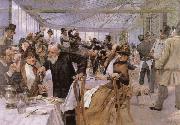 |
Hugo Birger
|
|
Swedish, 1854-1887
Swedish painter. He studied at the Konstakademi in Stockholm from 1871 to 1877. In 1877 he went to Paris and then spent the summer of 1878 at Barbizon with Carl Larsson, among others. There he painted several spontaneous plein-air paintings, such as Rue Gabrielle (1879; Goteborg, Kstmus.), in which the grey tones are contrasted realistically with exquisite colours. He also painted scenes of Parisian life, such as The Toilette (1880; two sketches in Stockholm, Nmus.), which aroused the interest of his contemporaries when it was exhibited at the Salon that year. Birger art was always conventional in style, allied to French salon painting. He was a master of technique and a brilliant subject painter, creating such scenes as In the Bower (c. 1880; Stockholm, Nmus.). |
|
|
|
|
|
 |
Hugo Loffler
|
|
1859-1935
painted Preparing for the lesson in 1896 |
|
 |
Hugo Muhlig
|
|
painted Knabe mit zwei Kaninchen und Vogelkafig in |
|
|
|
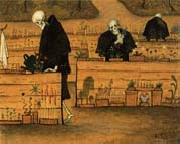 |
Hugo Simberg
|
|
Hamina 1873-1917 Ahtari, Finnish painter and printmaker. He first studied at the Finnish Fine Arts Association in Helsinki. His natural inclination towards mysticism led him to seek the instruction of Akseli Gallen-Kallela, with whom he studied in Ruovesi intermittently between 1895 and 1897. Gallen-Kallela's influence, in particular his Symbolist synthesis of the National Romantic style, is evident in Simberg's early works, such as Frost and Autumn (both 1895; Helsinki, Athenaeum A. Mus.), which are highly personal expressions of the mysticism of nature. |
|
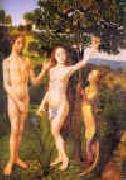 |
Hugo van der Goes
|
|
1440-1482
Flemish
Hugo van der Goes Galleries
Hugo became a member of the painters' guild of Ghent as a master in 1467. In 1468 he was involved in the decoration of the town of Bruges in celebration of the marriage between Charles the Bold and Margaret of York and he provided heraldic decorations for Charles's joyeuse entr??e to Ghent in 1469 and again in 1472. He was elected dean of the Ghent guild in 1473 or 1474.
In 1475, or some years later, Hugo entered Rooklooster, a monastery near Brussels belonging to the Windesheim Congregation, and professed there as a frater conversus. He continued to paint, and remained at Rooklooster until his death in 1482 or 1483. In 1480 he was called to the town of Leuven to evaluate the Justice Scenes left unfinished by the painter Dieric Bouts on his death in 1475. Shortly after this, Hugo, returning with other members of his monastery from a trip to Cologne, fell into a state of suicidal gloom, declaring himself to be damned. After returning to Rooklooster, Hugo recovered from his illness, and died there. His time at Rooklooster is recorded in the chronicle of his fellow monk, Gaspar Ofhuys. A report by a German physician, Hieronymus M??nzer, from 1495, according to which a painter from Ghent was driven to melancholy by the attempt to equal the Ghent Altarpiece, may refer to Hugo.
His most famous surviving work is the Portinari Triptych (Uffizi, Florence), an altarpiece commissioned for the church of San Egidio in the hospital of Santa Maria Nuova in Florence by Tommaso Portinari, the manager of the Bruges branch of the Medici Bank. The triptych arrived in Florence in 1483, apparently some years after its completion by van der Goes. The largest Netherlandish work that could be seen in Florence, it was greatly praised. Giorgio Vasari in his Vite of 1550 referred to it as by "Ugo d'Anversa" ("Hugo of Antwerp"). This the sole documentation for its authorship by Hugo; other works are attributed to him based on stylistic comparison with the altarpiece.
Hugo appears to have left a large number of drawings, and either from these or the paintings themselves followers made large numbers of copies of compositions that have not survived from his own hand. A drawing of Jacob and Rachel preserved at Christ Church, Oxford is thought to be a rare surviving autograph drawing. |
|
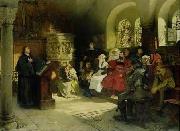 |
Hugo Vogel
|
|
painted Martin Luther preaching at the Wartburg in 1882 |
|
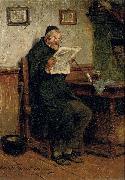 |
Hugo Wilhelm Kauffmann
|
|
(7 August 1844 - 30 December 1915) was a German painter, the son of Hermann Kauffmann.
Kauffmann was born in Hamburg. In 1861 he went to Frankfurt and worked there under Jakob Becker, Edward Jakob von Steinle and Johann Nepomuk Zwerger. From 1863-71 he lived in Kronberg in the Taunus. During this time he spent one winter in Hamburg and a five-month period in Desseldorf too; afterwards he spent 1½ years in Paris, until 1870 when the war drove him out. He lived until 1871 in Munich. He died in Prien at the Chiemsee in 1915.
|
|
|

